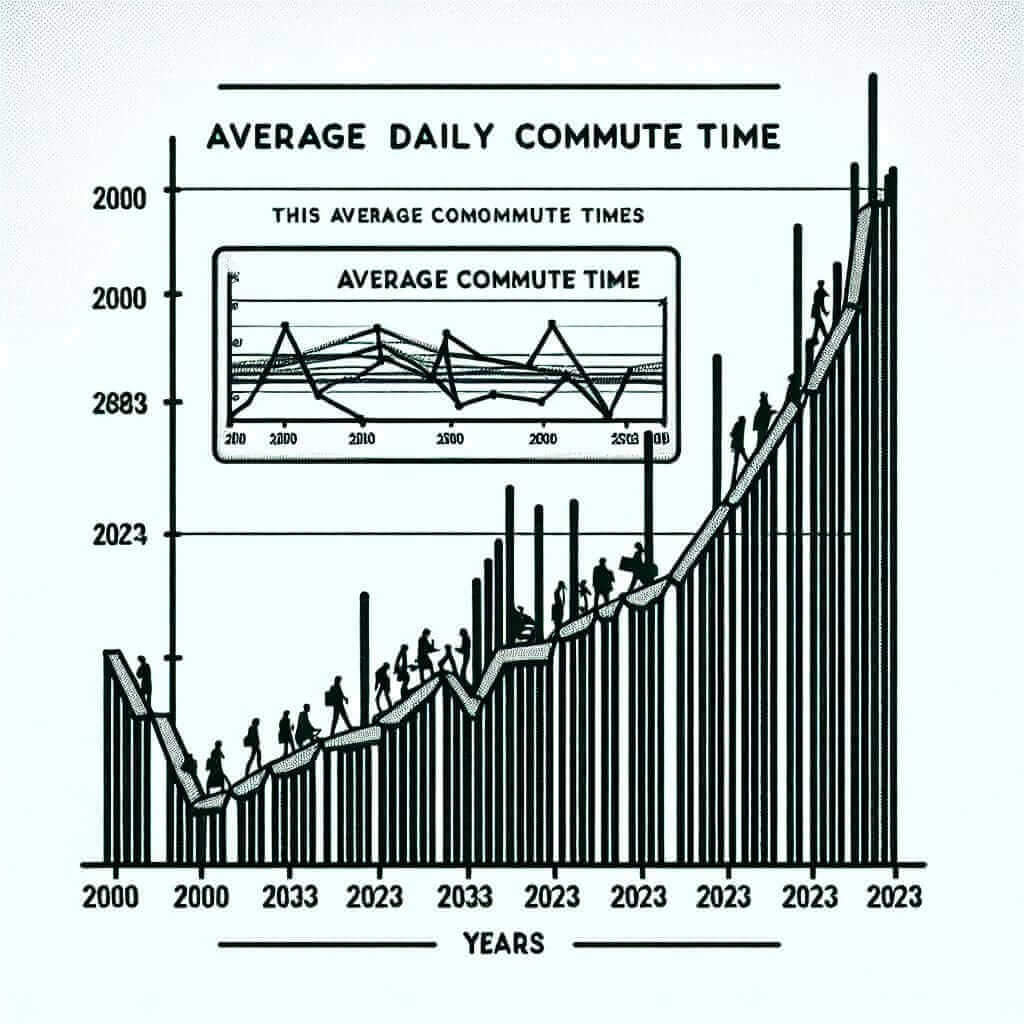Understanding the “Average Daily Time Spent Commuting (2000-2023)” is crucial, not just for those involved in urban planning or transport logistics, but also for IELTS candidates preparing for the Writing Task 1 section. This topic frequently appears in the form of charts, graphs, or tables, and comprehending such data will help you achieve a high score. Let’s delve into this topic and create sample problems and solutions to guide your IELTS preparation.
Sample Task 1 Prompts
- The chart below shows the average daily time spent commuting by individuals between 2000 and 2023 in City A. Summarize the information by selecting and reporting the main features, and make comparisons where relevant.
- The table below illustrates the average daily commuting time for workers in five different cities from 2000 to 2023. Summarize the information by selecting and reporting the main features, and make comparisons where relevant.
- The graph below gives information about the average daily time spent commuting by different means of transportation from 2000 to 2023 in Country X. Summarize the information by selecting and reporting the main features, and make comparisons where relevant.
Analyzing the Data
Selected Prompt:
The chart below shows the average daily time spent commuting by individuals between 2000 and 2023 in City A. Summarize the information by selecting and reporting the main features, and make comparisons where relevant.
Data Representation
To best visualize how this data can be presented in an IELTS task, let’s imagine a line graph showing these trends. Here is a hypothetical dataset for illustrative purposes:
| Year | Average Daily Commute (minutes) |
|---|---|
| 2000 | 60 |
| 2005 | 65 |
| 2010 | 70 |
| 2015 | 75 |
| 2020 | 80 |
| 2023 | 85 |
By creating this table, students can better understand how the robotic number trends across two decades.

Task Analysis
- Identify the main trends: Look at the overall increase or decrease in commuting time.
- Highlight specific points: Mention any significant years where notable changes occur.
- Make comparisons: Between different years within the dataset.
Model Answer
The line graph illustrates the average daily time spent commuting by individuals in City A from the year 2000 to 2023. Overall, there is a clear upward trend in the time people spend commuting over this period.
In 2000, the average time spent commuting was 60 minutes. This figure rose steadily to 65 minutes in 2005 and further to 70 minutes in 2010. The increase continued in the following years, with the average time reaching 75 minutes by 2015 and 80 minutes by 2020.
The sharpest rise occurred between 2020 and 2023, where the average daily commute time jumped from 80 to 85 minutes. This suggests that the factors influencing commute times became more pronounced during these years.
To summarize, over the span of two decades, City A experienced a consistent increase in the average daily time spent commuting, with the most significant rise noted in the last three years of the recorded period.Word count: 158
Writing Tips
Vocabulary
- Illustrate (v) – /ɪˈlʌs.treɪt/: To show the meaning or truth of something more clearly by giving examples.
- Trend (n) – /trɛnd/: A general direction in which something is developing or changing.
- Notable (adj) – /ˈnoʊ.t̬ə.bəl/: Worth noticing or important.
- Pronounced (adj) – /prəˈnaʊnst/: Very noticeable or marked; conspicuous.
- Span (n) – /spæn/: The length of time during which something continues.
Grammar Tips
- Tense Usage: Ensure the correct use of past simple and present perfect to describe past events and recent changes.
- Comparative Structures: Use comparative adjectives correctly to show differences (e.g., more significant, greater, higher).
- Adverbial Phrases: Use adverbial phrases to add detail to your descriptions (e.g., “over the span of two decades”, “in the following years”).
Important Points
- Be clear and concise: Avoid unnecessary details.
- Use appropriate linking words: Such as “overall,” “in summary,” “this indicates that,” to connect ideas smoothly.
- Maintain an academic tone: Use formal vocabulary and avoid conversational language.
Conclusion
Mastering the IELTS Writing Task 1 requires practice, especially when dealing with data-heavy prompts like the average daily commuting time. By following structured steps, utilizing precise vocabulary, and ensuring grammatical accuracy, you can produce a cohesive and comprehensive response that will score highly. Remember, clarity and organization are your keys to success!